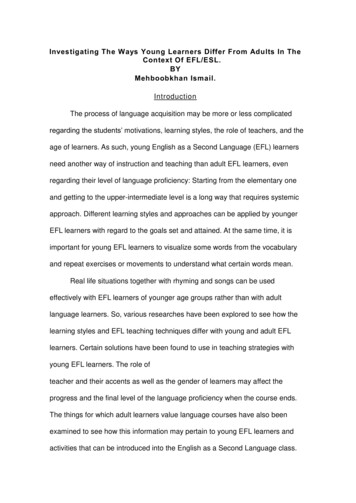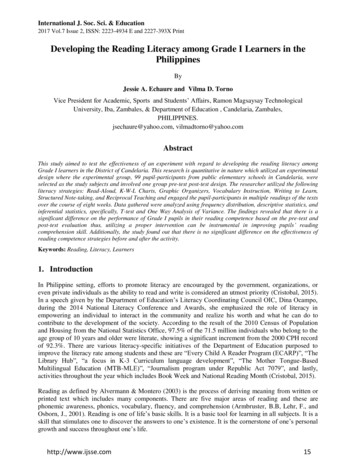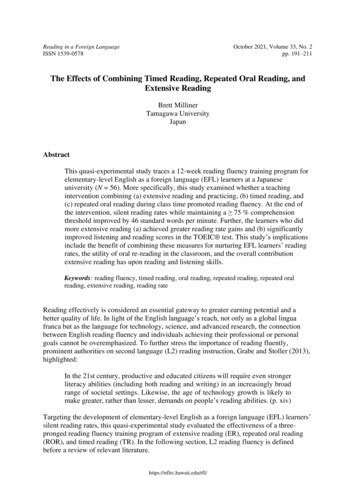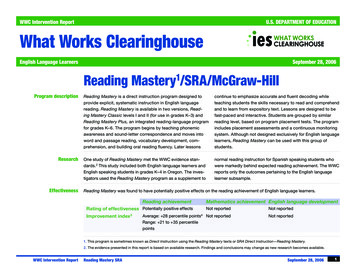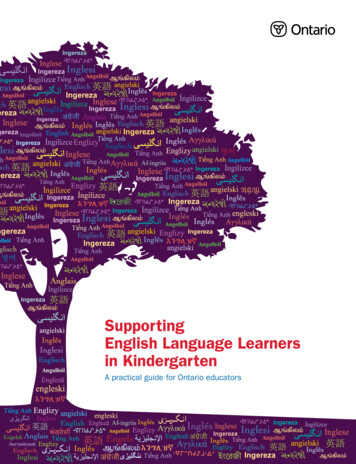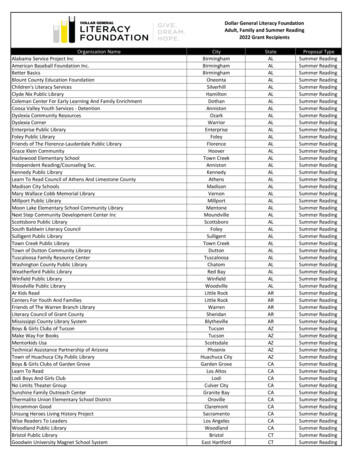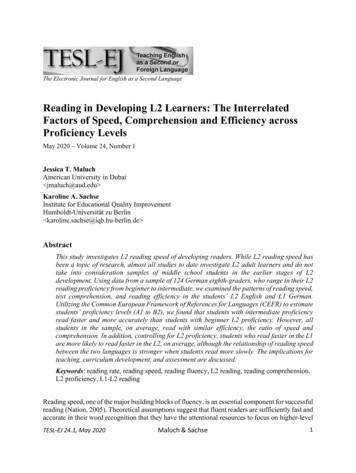
Transcription
The Electronic Journal for English as a Second LanguageReading in Developing L2 Learners: The InterrelatedFactors of Speed, Comprehension and Efficiency acrossProficiency LevelsMay 2020 – Volume 24, Number 1Jessica T. MaluchAmerican University in Dubai jmaluch@aud.edu Karoline A. SachseInstitute for Educational Quality ImprovementHumboldt-Universität zu Berlin karoline.sachse@iqb.hu-berlin.de AbstractThis study investigates L2 reading speed of developing readers. While L2 reading speed hasbeen a topic of research, almost all studies to date investigate L2 adult learners and do nottake into consideration samples of middle school students in the earlier stages of L2development. Using data from a sample of 124 German eighth-graders, who range in their L2reading proficiency from beginner to intermediate, we examined the patterns of reading speed,text comprehension, and reading efficiency in the students’ L2 English and L1 German.Utilizing the Common European Framework of References for Languages (CEFR) to estimatestudents’ proficiency levels (A1 to B2), we found that students with intermediate proficiencyread faster and more accurately than students with beginner L2 proficiency. However, allstudents in the sample, on average, read with similar efficiency, the ratio of speed andcomprehension. In addition, controlling for L2 proficiency, students who read faster in the L1are more likely to read faster in the L2, on average, although the relationship of reading speedbetween the two languages is stronger when students read more slowly. The implications forteaching, curriculum development, and assessment are discussed.Keywords: reading rate, reading speed, reading fluency, L2 reading, reading comprehension,L2 proficiency, L1-L2 readingReading speed, one of the major building blocks of fluency, is an essential component for successfulreading (Nation, 2005). Theoretical assumptions suggest that fluent readers are sufficiently fast andaccurate in their word recognition that they have the attentional resources to focus on higher-levelTESL-EJ 24.1, May 2020Maluch & Sachse1
comprehension processes (Gorsuch & Taguchi, 2008; Grabe, 2009; 2017) and ultimately moreenjoyment in reading (Nuttall, 1996). This is assumed for both native (L1) and second language(L2) reading. However, it is widely acknowledged that individuals do not read as easily or quicklyin their L2 as in their native languages (Alderson, 2000).Despite its importance, reading speed as a central building block of L2 learning has been largelyoverlooked in the empirical literature (Grabe 2009, 2010). To date, most studies on reading speedfocus on adult L2 learners (i.e., Chang, 2012; Fraser, 2007). These samples, which often come fromuniversity settings, already have developed advanced L1 reading skills, not to mention that theyhave more prior knowledge of how the target language works as a system as well as more selfawareness as language learners (Grabe & Stoller, 2011). It remains unclear if younger readers, whoare still developing their mother tongue language skills and awareness of themselves as languagelearners, show similar patterns of L2 fluency and how their developing L2 proficiencies and L1fluency skills affect these patterns.In the present study, we seek to address this gap by investigating reading speed in an understudiedpopulation of L2 readers whose abilities span across a range of levels, from beginner tointermediate, and, as younger learners, are still developing their L1 language skills. In thefollowing, we will first discuss the centrality of reading speed and its relationship to textcomprehension and efficiency. Then, we explore how the association between L1 and L2 readingspeed might differ across proficiency levels. Subsequently, we argue why current researchpotentially does not address important differences for developing readers.Literature ReviewThe Role of Speed, Comprehension and Efficiency in ReadingReading is a multifaceted activity that involves both lower-level and higher-level cognitiveprocesses (Grabe, 2009; 2017; Koda, 2005; Perfetti, 1999; Pressley, 2006). Lower-level processes,like word recognition, syntactic parsing, and meaning proposition encoding, are the building blocksthat support automatic and fluent decoding (LeBerge & Samuels, 1974). Higher-level processesallow the reader to use skills and strategies to understand meaning, interpret, make inferences andevaluate information in a text (Grabe, 2017). Although models of reading stress different pathstoward fluent reading (cf. the automaticity model by LeBerge & Samuels, 1974 vs. the interactivemodel by Stanovich, 2000), there is agreement that lower-level processing needs to be largelyautomatic to free up cognitive resources for higher-level comprehension processes (for discussion,see Fuchs, Fuchs, Hosp, & Jenkins, 2001; Grabe, 2009). If lower-level processes are not automatedand engage substantial attentional resources, the reader is unable to hold enough detail in the shortterm memory to permit interpretation of the overall text. In other words, there may be little capacityfor higher-level processes, hindering comprehension. Therefore, it is important for readers to havea certain amount of fluency to support accurate text comprehension (Kuhn & Stahl, 2003).Reading fluency, the ability “to read text rapidly, smoothly, effortlessly, and automatically withlittle attention to the mechanics of reading such as decoding” (Meyer & Felton, 1999, p. 284),depends on maintaining a certain reading speed (Hudson, Lane, & Pullen, 2005; Grabe 2010). Aneffective reading speed supports comprehension of the text (Grabe, 2010). While reading speed andtext comprehension may have a positive relationship (e.g., Segalowitz, 2000), it has also beenargued that reading speed decreases comprehension, placing speed and comprehension incompetition with one another (Brumfit, 1985; Champeau de Lopez, 1993; Carver, 1990). This mayresult from reading so quickly that it leads to ineffectual execution of low-level processes, resultingin reduced comprehension.TESL-EJ 24.1, May 2020Maluch & Sachse2
The combination of reading speed and text comprehension is reading efficiency (Carver, 1990;Geva & Zadeh, 2006). Also termed ‘effective reading speed’ (Jackson & McClelland, 1979), thenotion of reading efficiency emphasizes the importance of lexical retrieval process and their effectof reading comprehension (Perfetti, 1985). While reading efficiency and fluency overlap to somedegree, fluency incorporates a broader range of skills, while efficiency can be broken down to theproduct of speed and comprehension (Carver, 1990; Geva & Zadeh, 2006).Despite differences, reading fluency and efficiency can both vary depending on a reader’s abilityto process words automatically (Stanovich, 1980). This variation can be dependent on severalfactors, including age and proficiency (Chang & Millet, 2017; Grabe, 2009). Typically, youngerreaders have less automatic lower-level processes, like word recognition and word decoding, thanolder readers, who have greater capacity for word-recognition automaticity. This potentially assiststo free up the working memory for higher-level reading processes, making it easier to achievehigher reading speed (Grabe, 2009). Indeed, it has been found that younger readers have slowerreading speed than older readers and that reading speed increases on average of about 14 wpmevery year (Carver, 1990). Furthermore, a proficient L1 reader normally reads at about 250-300wpm, although this speed might differ depending on the difficulty of the text, the subject, and thetype of reading.In conclusion, effective reading demands a minimum speed to support the accurate comprehensionof the text. These two elements, speed and text comprehension, affect overall reading efficiency.The elements of speed, text comprehension, and efficiency may depend on both age and languageproficiency. In the following section, we will address if these patterns found in L2 reading mirrorthose in L1 reading.L2 Reading SpeedIt is widely acknowledged that individuals do not read as easily or quickly in their L2 as in theirnative languages (Alderson, 2000; Favreau & Segalowitz, 1983; Fraser, 2007; Segalowitz, Poulsen,& Komoda, 1991; Raymond & Parks, 2002; Roberts & Felser, 2011). One possible reason for thisdifference is that L2 readers have different cognitive profiles in their L1. Specifically, L2 learnershave more irregular patterns of fluency development and have less long-term memory in their L2as in their L1 (Fraser, 2007). In L2 reading, more attentional control is needed to focus on newwords, morphology, and syntax, which can result in a heavier processing load in the workingmemory (Taguchi, Melhem, & Kawaguchi, 2016; Segalowitz & Hébert, 1990) and slow down thereading process (Segalowitz & Hulstijn, 2005). These difficulties with lower-level processes cancreate a barrier to higher-level processes, resulting in slower L2 reading and affectingcomprehension (Grabe, 2009).As discussed above, reading speed and comprehension may complement each other or work incompetition. In L1 reading, several studies found a positive relationship between reading speed andcomprehension (e. g. Fuchs, et al., 2001; Hales et al., 2011; Jenkins, Fuchs, Espin, van der Beck,& Deno, 2000; National Reading Panel, 2000; Roberts & Felser, 2011; Pretorius & Spaull, 2016).However, this positive relationship does not appear to be equally strong at every stage of readingdevelopment, as there seems to be a strong association at lower levels in elementary school (Fuchs,Fuchs, Hamlett, Walz, & Germann, 1993) with the correlation decreasing as students advancethrough grades and as reading materials become more complex (Paris, Carpenter, Paris, &Hamilton, 2005).Other studies have found evidence that improved L1 reading rate does not always result in improvedcomprehension (Rashotte & Torgeson, 1985; Wexler, Vaughn, Edmonds, & Reutebuch, 2008). ForTESL-EJ 24.1, May 2020Maluch & Sachse3
example, in a study with 86 sixth and seventh graders, there was no significant association betweentext reading speed and comprehension which may reflect the decreased association between speedand comprehension found after elementary school (Hale, Skinner, Wilhoit, Ciancio, & Morrow,2012). Similarly, fourth-, fifth-, and tenth-grade L1 readers who read selected passages faster had,on average, lower levels of comprehension (Skinner, Williams, Morrow, Hale, Neddenriep, &Hawkins, 2009). This conflicting evidence might be due to the varying instruments used across thestudies to measure speed and comprehension as well as the proficiency levels of the samples.For L2 reading, there has been a dearth of studies investigating the relationship between speed andcomprehension. For beginning L2 readers, an increase in reading speed seems to be associated withan increase in comprehension (Chang & Millett, 2015; Taguchi & Gorsuch, 2002; Taguchi,Takayasu-Maass, & Gorsuch, 2004). Investigating the effect of a repeated reading intervention,Chang and Millet (2013) found that with a sample of 26 intermediate college students, improvedreading speed was associated with improved comprehension (also see Shimono, 2018). Severalother intervention studies with college students concluded that improved reading speed was notassociated with a change in comprehension (Chang, 2010; 2012) finding no association betweenthe components. In a reading intervention study with English as a Second Language (ESL)university students, improvement in reading rate was associated with a decrease in passagecomprehension (Cushing-Weigle & Jensen, 1996). One reason for divergent results may be due tothe fact that, similar to L1 students, the samples varied in their L2 proficiency.Investigating reading efficiency, or the ratio of speed and comprehension (Carver, 1990), may shedlight on lack of consensus in the aforementioned studies. While a few studies have explored L1reading efficiency and found it to be a strong predictor of reading comprehension, no known studiesto date have examined efficiency in L2 reading.The Relationship Between L1 and L2 Reading SpeedAn important factor that might further explain L2 reading speed is L1 reading speed. Currentevidence substantiates that L2 language learners read more slowly than L1 readers of the samelanguage (i.e. Cushing-Weigle & Jensen, 1996; Haynes & Carr, 1990). For within-subject designstudies, results show as much as a 30% difference in speed between the two languages (Segalowitz,Poulsen, & Komoda, 1991). With a sample of 95 fluent bilinguals who spoke L1 Chinese speakerslearning English, Fraser (2007) found a substantial gap between L1 and L2 reading speed.Furthermore, the study found that there was more variability in L1 reading speed than in L2 readingspeed, indicating a possible decreased efficiency in L2 reading. Other studies found that as L2proficiency decreased, the gap in speed between the languages increased (Favreau & Segalowitz,1983), indicating a potential nonlinear relationship between L1 and L2 reading speed.In sum, L1 reading speed appears to be an important factor that helps explain L2 reading speed.However, current research has yet to investigate the interrelatedness of all these constructs togetherespecially the possibility of a nonlinear relationship between L1 and L2 reading speed. All knownstudies to date have investigated their research questions with samples of adult participants, whohave a high level of L1 and L2 fluency. In addition, the lack of standardized proficiency measureshas made generalizations impossible for the classroom as well as testing situations.The Current StudyDespite the relatively few studies investigating L2 reading speed, current empirical research hasmade important first steps in exploring patterns in reading speed. However, to date, the majority ofstudies have used samples of adult learners, who are already fluent L1 readers. More research isneeded with varying samples, specifically with individuals of younger ages and those whose L24TESL-EJ 24.1, May 2020Maluch & Sachse
reading proficiency ranges from the beginner to intermediate level. Further, it is important to usestatistical methods that allow not only to see descriptive trends in the sample but also the possibilityto make inferences about a larger population of L2 learners. Lastly, because proficiency could affectthe patterns in reading fluency and L2 populations are extremely varied (Grabe, 2009), it isimperative to use a standardized metric of L2 proficiency in order to generalize for language testingas well as classroom practices. Based on the general dearth of research on L2 reading fluency andmore specifically on current gaps in the literature, we asked the following research questions:RQ1: Does L2 reading speed and L2 text comprehension differ across proficiency levels asmeasured by the CEFR? Do students with different L2 proficiency levels differ in their readingefficiency?RQ2: What is the association between L2 and L1 reading speed for students still developing theirfluency skills in both languages?MethodsParticipantsConducted in September 2012, the Institute for Educational Quality Improvement (IQB) sampled126 eighth-graders from three randomly selected schools in three German federal states. Theschools represented three different school tracks: lower vocational track (27%), middle vocationaltrack (31%), and university-bound track (42%). 64 (52%) were girls (five students did not indicatetheir gender). The students’ age ranged between 13 and 16 years (M 14.84, SD 0.87). None ofthe students were English native speakers, about 90% spoke only German at home and almost 10%spoke mainly German plus another language (not English). All students in the sample had Germanas their L1 and English as their L2. The two students who indicated that they spoke mainly alanguage other than German at home were excluded from further analysis (Nfinal 124).MeasuresL2 reading speed, text comprehension and efficiency. To estimate the students’ English readingspeed, we administered a 20-minute test with eight authentic texts. We presented students with alltexts consecutively. Figure 1 shows an example of a sample task with authentic text andcomprehension questions. For each text, we stopped them after 30 seconds, and asking them tomark how far they read with a slash in the text (/), we counted the number of read words to measurethe student’s reading speed. During pilot testing, students were asked to stop and mark how muchthey had read after one minute. Students tended to complete the text, resulting in a ceiling effect.Because of this, we decided to reduce the allotted time from one minute to 30 seconds. To avoidpossible metric inflation, all English reading speed results will be presented in words per 30 seconds(words/30s). After marking how far they had read in the text, participants were given an additionaltwo minutes to complete the reading of the text and answer multiple-choice questions addressingthe text. The students’ English comprehension was operationalized as the percentage ofcomprehension questions answered correctly. After answering the comprehension questions, thestudents were presented with the next text. The position of the texts was rotated to create fourdifferent booklets to minimize individual affective and task placement effects. To measure readingefficiency, we computed a reading rate equivalent to that of Skinner and colleagues (2009), whichwas the percentage of comprehension questions answered correctly (comprehension) divided bythe number of words read in 30 seconds (reading speed).TESL-EJ 24.1, May 2020Maluch & Sachse5
Figure 1. Example of Task (as published by Leucht, Retelsdorf, Möller, & Köller, 2010).L2 reading proficiency in English as a first foreign language (CEFR reading test). Weadministered a 20-minute paper-pencil test of 30 tasks aligned the German National EducationalStandards (NES) developed by the Institute for Educational Quality Improvement (IQB) based onthe Common European Framework of References for Language (CEFR) (Council of Europe, 2004).The standardized tasks were developed, calibrated, and validated by the IQB in order to assessEnglish as a first foreign language in German secondary schools (Harsch, Pant, & Köller, 2010;Rupp, Vock, Harsch, & Köller, 2008). The tasks had a variety of subjects as well as formats. In aprevious standard-setting study based on a large nationally representative sample and internationalexperts, cut-scores were set that divided the scale of all tasks transformed IRT difficulty parameterinto stages that correspond to the CEFR levels (Harsch, Pant, & Köller, 2010). Five plausible values(PVs) were generated using the generalize item response modeling software, ConQuest (Wu,Adams, Wilson, & Haldane, 2007) and pooled according to Rubin (1987) to create a compositeEnglish reading proficiency.TESL-EJ 24.1, May 2020Maluch & Sachse6
L1 German reading fluency test for 6-12 graders (LGVT6-12). We administered thestandardized LGVT6-12 to estimate students’ German reading speed (Schneider, Schlagmüller, &Ennemoser, 2007). This test consists of a single text of 1,727 words with imbedded word choicequestions to estimate text comprehension. Students were asked to read and fill in the correct wordswithin a four-minute period. Because of the differences between the instruments for L1 and L2reading speed, we report L1 reading speed as standardized percentiles to avoid direct comparison.ProcedureThe data were collected in a classroom setting administered by independent test administratorsduring a normal school day. The administrators read the standardized instructions of each sectionto the students before the beginning of each section. First the students completed the Englishproficiency test followed by the reading speed and comprehension test. After a five-minute break,the German LGVT6-12 was administered followed by a student questionnaire. With instructionsand break, it took approximately one hour to complete the entire test booklet.Statistical AnalysisTo investigate reading speed in L2 learners, we first computed descriptive statistics to appraise thedependent variable L2 reading speed as well as the independent variables. Then, to address our firstresearch question, we computed descriptive statistics by students’ proficiency levels. Finally, toaddress our second research we fit a series of regression models to explain L2 reading speed. Thedescriptive statistics were computed using Stata (StataCorp, 2007). The regression analyses wereconducted in R 3.1.2.ResultsDescriptive StatisticsTo investigate reading speed in L2 learners, we examined L2 reading proficiency, the dependentvariable L2 reading speed, L2 comprehension, as well as L1 reading speed in our sample.First, we examined the distribution of L2 reading proficiency in our sample as measured with theCEFR reading test. The mean of the five plausible values for L2 reading ability (M 462) indicatesthat our sample of eighth-graders did not perform as well as the national population of Germanninth-graders (M 500, SD 100) but had a similar variance (SD 97.65). The distribution in thesample of the students’ English reading proficiency ranged between CEFR levels A1 and B2. Moststudents had a reading level of A2 (n 52) or B1 (n 36) with several performing at an A1-level(n 30) and very few reaching a B2-level (n 6).For the dependent variable L2 reading speed, the descriptive statistics show that all students in thesample read, on average, 103 words per 30s (SD 29). Reading speed was almost normallydistributed across the sample with no floor or ceiling effects (see Figure 2).TESL-EJ 24.1, May 2020Maluch & Sachse7
Figure 2. Distribution of L2 (English) Reading Speed (words/30s) in the Sample.We next estimated descriptive statistics for L2 comprehension. Students’ comprehension rangedfrom 0.17 to 0.83 percent (M 0.50, SD 0.16) and also appeared to be normally distributed withno floor or ceiling effects.Finally, we examined the descriptive statistics for L1 reading speed. The L1 reading percentileswere distributed normally in the sample with a mean of M 53.53 and a standard deviation of SD 10.67, reflecting a slightly faster reading speed and variance than the eighth-graders in the readingspeed norm study (M 50, SD 10).L2 Reading Speed, Comprehension, and EfficiencyGiven our substantive interest in L2 reading speed and comprehension across proficiency levels(RQ1: Does L2 reading speed and L2 comprehension differ across proficiency levels as measuredby the CEFR?), we first considered L2 reading speed, comprehension and efficiency for L2proficiency levels A1 to B2 (see Table 1). As shown, there is a progressive increase in L2 readingspeed from levels A1 to B1 with no substantial difference between L2 reading speed for B1 leveland B2 level students. Students at beginner levels (A1 and A2) have a larger variance (as shownwith the standard deviation) in their reading speed than students at the intermediate levels (B1 andB2). There is a noticeable increase in the percentage of L2 comprehension for students across thefour proficiency levels with similar variances across the four groups.TESL-EJ 24.1, May 2020Maluch & Sachse8
Table 1. Sample means (and standard deviations) of L2 Reading Speed, Comprehension, andEfficiency across CEFR Levels.A1n 30A2n 52B1n 36B2n 6L2 reading speed )L2 comprehension 0.39(0.15)0.47(0.15)0.60(0.10)0.63(0.15)L2 003)Next, to address the second part of our first research question (Do students with different L2proficiency levels differ in their reading efficiency?), we combined the factors of L2 reading speedand comprehension, estimating L2 reading efficiency (see Table 1). Students across proficiencylevels have similar efficiency in their reading, on average. However, there is a larger efficiencyrange for students at the A1 proficiency level compared to students at the other reading proficiencylevels. To test for difference in efficiency across proficiency groups, we conducted Tukey’s HSDtest. We found no statistically significant differences between efficiency across proficiency levelsindicating that the ratio between speed and comprehension is similar across different L2 proficiencylevels. Figure 3 illustrates the lack of difference in mean L2 reading efficiency across proficiencylevels. However, it shows how students who are reading at an A1 level have a wider variation ofefficiency compared to their peers with higher L2 proficiency.Figure 3. Boxplots of L2 Reading Efficiency across Proficiency Levels.TESL-EJ 24.1, May 2020Maluch & Sachse9
L1 and L2 Reading SpeedTo investigate the relationship between L1 and L2 reading speeds (RQ2: What is the associationbetween L2 and L1 reading speed for students still developing their fluency in both languages?),we estimated a series of linear regression models with L2 reading proficiency groups (A1 to B2) asa series of ‘dummy’ variables and students with A1 reading proficiency as the reference group anda combined B1/B2 group due to the small sample size of the B2 group (see Table 2). In Model A,we regressed the variable L2 reading speed on the L2 reading proficiency groups. As shown inModel A, students in the A2 and B1/B2 proficiency group read significantly faster than their peersin A1. This suggests a positive trend between proficiency and speed for beginner and intermediatereaders. Reading proficiency group membership explained just about one quarter (24%) of thevariance of L2 reading speed in the sample.Table 2. Multiple Regression Models Explaining L2 Reading SpeedModel AInterceptModel B77.105*** 5.013.28Model C9.96 -103.43* 45.39L2 reading proficiency A228.58*** 6.16 18.49*** 4.97 16.55**L2 reading proficiency B1/B238.64*** 6.33 21.31*** 5.33 18.55*** 5.34L1 reading speed1.58*** 0.192L1 reading speedAdjusted R20.240.524.935.65**1.70-0.04*0.020.54In Model B, we added our question predictor, L1 reading speed, to the model. Controlling forL2 reading proficiency, L1 reading speed explained an effect in addition to L2 readingproficiency (βL1ReadingSpeed 1.58, p .001). The addition of L1 reading speed in Model Bresults in a 28% increase in explained variance. The results show that students who read fasterin their L1 also read faster in the L2, even after controlling for their L2 reading proficiency.Finally, as indicated in previous studies with descriptive statistics, we added a quadratic termto explore whether the relationship between L2 and L1 reading speed is linear (Model C). Theaddition of the L1 reading speed quadratic term revealed a significant nonlinear relationshipbetween L1 reading speed and L2 reading speed (βL1ReadingSpeed2 -0.04, p .02). This modelresulted in the best model fit explaining 54% of the overall variance in L2 reading speed.Figure 4 depicts Model C, illustrating the quadratic relationship between L1 reading speed andL2 reading speed for A1, A2, and B1/B2 students. This shows that, controlling for L2proficiency, students who read faster in their L1 also read faster in their L2. However, the effectof L1 reading speed is greater for those students who read more slowly. The faster studentsread in their L1, the less the reading speed in their two languages are related. In other words,the effect of change in L1 reading speed is greater for students with slower L2 reading than forstudents with faster L2 reading.TESL-EJ 24.1, May 2020Maluch & Sachse10
Figure 4. Nonlinear Relationship between L1 Reading Speed (in Standardized Percentiles)and L2 Reading Speed (words/30 secs).DiscussionIn the present study, we examined L2 reading speed in a sample of beginning and intermediate L2middle school readers. Specifically, we investigated two research questions: (a) if L2 reading speed,comprehension, and efficiency differ for students across L2 proficiency levels; and (b) to whatextent L2 and L1 reading speed are related. To this end, we first analyzed the association betweenL2 reading speed and comprehension and additionally built a composite of reading speed andcomprehension to compare efficiency across the different proficiency levels. Then, to answer thesecond research question, we specified linear regression models to evaluate the relationshipbetween L1 and L2 reading speeds.The results provide evidence that L2 reading speed and L2 comprehension differ systematicallyacross proficiency levels. As predicted, students who have higher L2 proficiency read faster andmore accurately than students with lower L2 proficiency. The descriptive statistics foreshadowedthat positive association found between L2 reading speed and comprehension. These resultsreinforce the theoretical assumption that individuals at the beginning of L2 learning focus moreattention on their lower-level processes slowing down their reading (i.e. Segalowitz & Hulstijn,2005). As their ability increases, these processes become more automatic resulting in increasedfluency. These findings parallel those reported by Taguchi and colleagues (Taguchi & Gorsuch,2002; Taguchi et al., 2004), who also found a positive association between speed andcomprehension in beginning L2 adult readers. Similarly, the findings of the present study reflectthose of Chang and Millet (2013) who also found a positive relationship between L2 reading speedand comprehension in intermediate L2 readers. At the same time, they contrast with the resultsfound in more advanced language learners (Chang, 2010; 2012; Cushing-Weigle & Jensen, 1996).Taken together, these findings suggest that there may be a stronger association between readingspeed and comprehension at earlier stages of language learning. Similar to L1 reading, as studentsdevelop their skills in L2 reading and the reading materials become more complete (e.g., Paris etal., 2
reading proficiency from beginner to intermediate, we examined the patterns of reading speed, text comprehension, and reading efficiency in the students’ L2 English and L1 German. Utilizing the Common European Framework of References for Languages (CEFR) to estimate students’ profi

